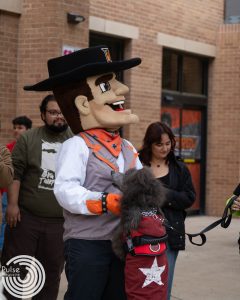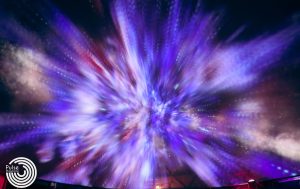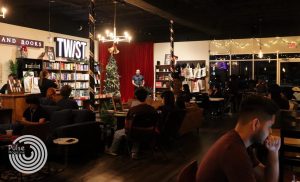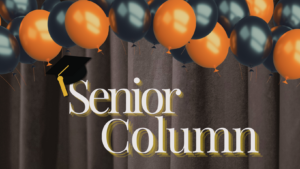Q&A with Author Kimberly Garza
Graphic by: Gonzalo Puente
“The Last Karankawas” is a collective story made up of many faces, voices and experiences. From Galveston to Uvalde to Brownsville, Dr. Kimberly Garza has mapped out the people and places of Texas. The reader gets a little insight into everybody in the small community of Fish Village in Galveston. The interwoven stories all connect through Carly, a young woman of Filipino and Mexican descent who has been raised by her grandmother since the age of 6. In 2008, with the looming monster of Hurricane Ike on the horizon, Carly, her grandmother and the community of Fish Village had to decide whether to risk their lives and ride out the hurricane or leave their homes. The first draft of the book was written while Garza was in graduate school at UT Austin and revised and edited in quarantine during COVID. It was published by Macmillan in 2022. Garza is currently working on her second book for Macmillan.
Tell us a little bit about your background.
“I am a Texas writer born and raised. I was born in Galveston but I grew up in Uvalde. Just as far as my background as a writer, or my path to a writer, I went to UT Austin for undergrad; as an English and Spanish major and I got into journalism. I thought at the time [that] I wanted to be a writer. I didn’t really know how. I didn’t know anybody who had done that. I didn’t have any role models to look up to. So, I just said, ‘I think journalists get paid, let’s do that’. Both my parents were in the medical field, so this was something totally new to them and I think everybody sort of doubted that I’d be able to do it. So, I was just kind of looking for a way to survive [more] than anything that I was gonna get rich off of. So, I did journalism as my career for a couple years. In between, I got my master’s at UT Austin in creative writing because I wasn’t done with it. I wanted more time with it. After that, I went back into journalism for a while and at a certain point after my master’s, I just realized that this is what I’m gonna do. I’m gonna go back to school. I knew I wanted to get a PHD because, like I said, my parents were in the medical field; my mother had a PHD. So, I was thinking about academia too. I didn’t really know if it would be a good fit. When I went back to [get] a PHD, I went to the University of North Texas and I was in their creative writing program. That’s really where I learned how to hone my writing. I found my voice in a lot of ways. I wrote what ended up being my dissertation, which was the first draft of my novel. So, when I left there, I was fortunate enough to get a job here at UT San Antonio and so, it’s like a homecoming. I came back. In a lot of ways, I came back home after being away. Then from here, as I was teaching, I was encouraged to publish and research. I finished revising my book, I secured an agent, and then we sold it and it’s been out in the world and … I’ve continued my day job along with it. I just got tenure at UTSA earlier this year. … I didn’t come directly at it, is what I’m saying. I don’t know many people who do. But I didn’t know anybody who had ever done that. So, I just sort of found my way into writing.”
When did you know writing was going to be something that you pursued? Was there a moment or a time in your life [where you knew]?
“Something that I wanted to pursue or something that I could [pursue]?”
Something that you could pursue.
“I was the typical kind of writer kid where I was just reading a lot. I read constantly to the point where it was my whole identity for [my] whole childhood. I think right around high school, where you start having those conversations with yourself about what’s next, what do I do? … In my family, my parents were first [generation] college students and so, for me, it was gonna be college. They’d worked really hard and my mother was an immigrant. They were like, ‘You’re going to college.’ I think I was thinking seriously about what I wanted to major in … and the only thing I imagined remotely wanting to do or being good at was English. … I just figured I’d find a way. I think in my mind, I figured if I had a writing job, like some sort of writing adjacent career, that I could write creative stuff at home. I could go home and write my novel. I could go home and write my short stories. So, I was just looking for any day job that let me be a writer and let me use my English degree. I just kind of fell into journalism as a student, because I worked for the student newspaper at UT Austin, The Daily Texan. Then, my first job out of college was at a magazine, because I’d had some journalism experience, and I interned at Texas Monthly. So, I just kind of decided in high school and made it happen in college that I was somehow going to be a writer.”
So, you were born in Galveston and it’s also a major setting of your novel. Can you tell us a little about what Galveston means to you?
“It’s very special to me. I think there’s something really different about calling a place your hometown. I wouldn’t call Galveston my hometown. Uvalde is definitely my hometown, but [Galveston is] special to me. I was born there; I feel very strongly that we’re tied to places innately. When I go back to the island, I feel this sense of calm. I feel this sense of connection to the place. It was also where, up until my 20s, it was where a lot of my family lived. My mother, when she emigrated from the Philippines and started having her family come over to join her in Texas … My family lived in Galveston. So, to me, Galveston was just like my Filipino side. I got to go to Galveston to be Filipino. I couldn’t really be Filipino in Uvalde. There just wasn’t enough of us. But in Galveston [and] Houston I could. There were a lot of Filipinos, so there I got to see my grandparents. I’d see my aunts and uncles. I’d see all of my family friends that I called aunts and uncles. I’d see my cousins, who were cooler than me and all a little older, and they all lived in Galveston. It continues to be very special to me. … I can’t scratch the surface of how interesting that place is. It’s fascinating. It’s got this wild history. There’s books on books on books being written about Galveston and there should be many more. It’s this really kind of spectacular and wild history to it.”
So, you write about characters from a lot of different backgrounds. They are all kind of grappling with identity: who they are and their connection to a place. Can you tell me a little bit more about that?
“It is a common theme in the book. I didn’t really intend it to be a theme. I think a lot of writers can do this beautifully. I can’t. If I start with a theme, it just feels too preachy. So, I just kind of wrote people that became interesting to me. I dove into their different backgrounds and some of them are closely connected and some of them are a little more skewed. I’ve got people of different ethnicities and homelands and career paths and different ages, too. But I wanted to see a way where they were all at a basic level, questioning the same things. The white guy from Kerrville can also have the same questions as an undocumented migrant from Mexico living in Brownsville. … I wanted to intentionally sort of draw those parallels between all the characters, as diverse as they were. I think at its core, in my book, at least, it’s something that I think about a lot. I really wanted to see how these characters latched their identity onto a place. If you’re in a place like Galveston, or in a place like the Valley, or a place like Uvalde and you’re from there or not, or you’re born there or not, how does being from this place and living there now create who we are? Because I feel differently on any given day. So, I tried to show the characters all dealing with that in a really different way. Some of them are very proud of being born in a new place and arriving to Texas and trying something new or arriving to Galveston and trying something new. Some of them are very proud to be rooted to a place and stay there forever and they think that that defines them. Some people grapple with it and kind of have different feelings about it. So, I think that, for me, that was really important to try to portray in the book. I continue to be really moved when people tell me that that stands out to them in the book or that it resonates. It hits with them.”
Where does the book’s title come from?
“There’s a wide cast of characters. They’re all kind of loosely connected to this neighborhood, in Galveston in particular, called Fish Village. But at the core of the group is this young woman named Carly who’s grown up in Galveston. She’s born on the island. She’s been raised there by her grandmother, whose name is Magdalena, and Magdalena has taught her that they are descendants of the Karankawa people. Magdalena believes this because she’s been told this and it’s a story that’s been passed down her family. She has no evidence. She has no particular affiliations. I know the Karankawa people who are very much still in existence, are not extinct, like Carly, and like many of us, were taught. That’s not the case. But the belief that Magdalena has … she doesn’t know of any other Karankawa people so she … believes that Carly, as her granddaughter, is one of the last. And that ends up affecting the way Magdalena feels about Galveston. The Karankawa were Indigenous people along the coast, including a very rich history in Galveston. Carly feels differently about being tied to Galveston, whether she’s Karankawa descendant or not. … It speaks to a lot of those questions that everybody is grappling with. Who gets to say they’re from anywhere? The idea of them being descendants from Indigenous people kind of hovers over Carly and Magdalena’s existence in the book. … How do different people grapple with where they’re from and who they are?”
What gives you the urge to write? Has it always been the same urge?
“I think it’s changed since I was a younger writer. I think as a kid I just had way more energy. … You couldn’t stop me from reading. You couldn’t stop me from writing. I’d fill pages and pages of a notebook. Or when I finally got a laptop, I would fill documents of just ramblings and stories and things like that. Now that I’m older, the urge is harder. … I’m constantly thinking about my writing, and right now I’m working on a novel, so if I’m not writing, I’m thinking about it. I’m trying to revise it in my head or I’m plotting a couple of steps forward. I think the energy for writing is a little different now that I’m older. I guess it’s just life. I sit down to write and I’m probably thinking about that email I’m supposed to send right now or that paper I’m supposed to grade or that phone call I have to make. I think that life just sort of catches up with you, but the thing that I found most rewarding is that I still do have those moments that you mentioned where something will occur and I’m like, ‘Oh, I’ve got to write.’ And honestly, when that usually happens is when I’m reading. So, I still try to make as much time as possible. If I’m not writing, I try to read if I can’t push myself to write or I just don’t feel the words coming out and everything feels like garbage. If I read something, I’m often really inspired to write. There’s so many beautiful books out there. It might be a plot twist or it might be a line of dialogue or just a line of description and it immediately kind of churns something in the brain that makes me go, ‘Ooh.’ I take a lot of notes on my phone sometimes, which I don’t write on my phone, but usually that’s what I have. I don’t have my laptop with me like on the bus. I’ll jot down something on my phone that speaks to me. So, I’ve got one note that’s just got a bunch of random lines in there to where I’m motivated to start writing.”
What is your approach to character-building? What do you set out to do?
Character building is so tough and it’s really important. I think most of my stories really thrive on character. I would say that when I start with a story I usually start with place because place just works for me. I feel like I immerse myself in a setting and I can at least start there. I can describe the setting and I can work it into the words until I feel like I’m there and then I create a person who’s there. Then, I try to invent a backstory. Are they from there? That makes a big difference, right? Did they find themselves there? How do they feel about where they are? Do they love it? Do they hate it or somewhere in between? I often always start with a character who has found themselves in this place for whatever reason and then I work backwards from there. Like, how old are they in this moment and where do they come from? Go to their backstory. It’s trial and error, honestly. Characters change. My students and I talk about this a lot in our creative writing classes. I can spend days, weeks, months, creating a character and as soon as I start to write the story and I put them in the story, they change. They become different people. They surprise me constantly. That’s part of the fun of it. The more I write, the more I spend time with them and the more I realize the ways in which they’re their own person. I don’t want them to go in that room but they are gonna go in it. I don’t want them to say that line but it turns out they are gonna say it. So, they just become real people to me after I’m done thinking and when I start thinking on the page. That’s probably my best description of my process there because I will spend too much time thinking about them but it also has to come with the writing.”
So, I heard that you didn’t write the bulk of the story during COVID but maybe you were working on it during COVID. What was the process like?
“Yeah, I was revising it. So, early 2020, I signed with my agent. I graduated in 2019 and then in Fall 2019 I started working at UTSA. Over winter break, after I had wrapped my head around classes and being a professor for that first semester, I did some finishing revising to the book. And I thought, “Ok I’m ready to send it out.” There’s a step that has to happen before you submit for publication to the “Big Four” publishers, which is that you have to have an agent. Not the case for every publishing path but that’s the one that I wanted to go down. Over winter break and into January and February, I was submitting the manuscript to [literary] agents, querying agents, to see if they’d represent me. I signed with my agent in … February or March of 2020 and then everything shut down. So, his plan initially had been [to] make a few tweaks. He had agents often give you their thoughts on your manuscript because they are good readers of your work, ideally. He had a lot of thoughts on how I could revise it. He was like, ‘Let’s get it done by summer. We will send it out in summer and let’s see what happens.’ That did not happen because there were many months where everybody in New York was not doing anything. They were surviving. So, he kept in touch with me and was like, ‘We are not sending yet. Nobody is reading.’ In that thick of it, we were both just communicating like what the hell is happening? What are we doing? Is there any point to me writing a book? Is the world gonna end? What is this? … Over the summer, when we were pretty much quarantined, I took the time to revise. He had a lot of thoughts and I thought this is something I could do and so I took my time with it. I revised it. I revised them individually and sent it back to him and he sent me one more round. So, I really took my time revising it, getting it ready to submit. He thought, well we’ll play it by ear, but possibly by fall, people will be getting ready to read again. And it turns out they were. We got it ready and we started sending it out by September. We made the deal with the publisher in October of 2020. … So, one good thing to come out of 2020. It took a lot out of me to revise. It probably would’ve taken a lot out of me to write. I wasn’t really writing anything new. I was just working on this. It was hard. I wasn’t seeing people, and I’m a bit of an extrovert, so I was very isolated. Just me and my words for long days. And of course, [there was] the worry about everything that was going on. So, it just took a toll mentally and emotionally. But I’m very grateful that I got to spend time with it that I wouldn’t have otherwise.”
What authors influenced your work in “The Last Karankawas”?
“I think most good writers are a little bit like sponges and we just soak up everything. Whether we know it or not, whether it’s evident or not in the particular piece, I’m really just a reflection of all of the great writing that I’ve read and the great stories I’ve been told. I come from a family of storytellers. All the good stories that I’ve been told and told and told, I’m just adapting them in a lot of ways. I think probably one of the stronger ones, and she’s been a great influence on me as a younger writer, too, and even now, is probably Sandra Cisneros. “The House on Mango Street” is the first book of hers that I ever read and I read it in ninth grade, freshman English, and it was one of the first books that I’d ever read by a Latina author. I’d read a lot of white dudes. I’d read a lot of dead people. So, I got to read this book that said Cisneros and I said, ‘What?’ Also, just the way it was written, I’d never seen … a novel of short stories that is linked like a novel in stories. Whatever you want to call that book, it kind of defies definition. But I loved the way that you got little fragments of people who were part of this neighborhood, and in doing so, you got a story of the whole neighborhood. That was a really clear influence on “The Last Karankawas” because I love the idea of telling a story about a place that’s not clearly defined and would be doing itself a disservice if we just had one definition of it. If it was just Carly’s Galveston in the book, what a boring Galveston. So, instead, we get Carly’s and Magdelena’s and Jess’ and Mercedes’ and Pierre’s and Ofelia’s and all of these people’s versions of Galveston. “The House on Mango Street” was a big influence. There’s a Filipina writer who I love, whose name is Mia Alvar, and she wrote a collection of short stories called “In the Country”. That’s a little bit more recent. … I was just really sadly behind in reading a lot of Filipino writers. I didn’t grow up reading them and my mother didn’t know of many because she also didn’t read many. As a kid, they read American writers. They read Spanish writers, British writers. So, I really had to seek out Filipino writers and it was really important for me to do that because I knew I was going to have Filipino characters. I wanted to see the ways that other people are writing them. [Alvar] had this really beautiful collection that is a bunch of different stories about the diaspora: the idea of Filipinos who move all around the world and what that loneliness and that kind of migration does to a person who has a homeland and what homeland looks like after that. So, that one kind of inspired me as well to think about how my Filipino characters in this book kind of grapple with moving back and forth between the US and the Philippines, which many of them do.”
Is there anything else that you would like to add about your book that we should know?
“I always try to let people know that it’s a novel in stories, in the way that I hope that people approach “The House on Mango Street”. It’s a different kind of novel. It’s telling a collective story through many voices and through many little snippets of experience. I think that, for me, that was the only way to tell a story about Galveston. It’s a story about a place. … One thing that I’ve been really proud of is the people that this does click with. It’s hopefully a surprise to many people to see a story like this and I certainly hope it’s not the last. If it’s the first, that makes me very proud. … It’s a strange kind of story but I think it’s the only way to really appropriately tell a story about a place. There’s so many people that have gone into creating a place throughout history. I’m thinking of the Indigenous people who settled these places. They were the original inhabitants. The places kind of carry the memory of all of these voices and all of these people, so that was the way I was going to tell this [story]. So, I hope it speaks to readers. I hope it hits people who are looking for a story told that way.”





